QF 3-pounder Hotchkiss
The QF 3-pounder Hotchkiss or in French use Canon Hotchkiss à tir rapide de 47 mm were a family of long-lived light 47 mm naval guns introduced in 1886 to defend against new, small and fast vessels such as torpedo boats and later submarines. There were many variants produced, often under license which ranged in length from 32 to 50 calibers but 40 caliber was the most common version. They were widely used by the navies of a number of nations and often used by both sides in a conflict. They were also used ashore as coastal defense guns and later as an anti-aircraft gun, whether on improvised or specialized HA/LA mounts.
| Hotchkiss 47 mm L/40 M1885 & QF 3-pounder | |
|---|---|
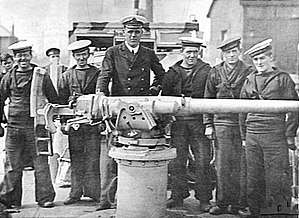 A Royal Navy 3-pounder on a central pivot mount in 1915. | |
| Type | Naval gun Anti-aircraft gun Coastal artillery |
| Place of origin | France |
| Service history | |
| In service | 1886–1950s |
| Used by | See users section |
| Wars | See wars section |
| Production history | |
| Designer | Hotchkiss |
| Designed | 1885 |
| Manufacturer | Hotchkiss et Cie |
| Produced | 1886 |
| No. built | 2,950 (UK) |
| Variants | 32 to 50 calibers in length[1] |
| Specifications | |
| Mass | 240 kg (530 lb) |
| Length | 2 m (6 ft 7 in) |
| Barrel length | 1.8 m (5 ft 11 in) 40 caliber |
| Shell | Fixed QF 47 × 376 mm R Complete: 3 kg (6.6 lb) Projectile: 1.5 kg (3.3 lb)[2] |
| Calibre | 47 mm (1.9 in) |
| Breech | Vertical sliding-wedge |
| Elevation | Dependent on mount |
| Rate of fire | 30 rpm[3] |
| Muzzle velocity | 571 m/s (1,870 ft/s) |
| Maximum firing range | 5.9 km (3.7 mi) at +20° 4.5 km (2.8 mi) at +80° |
Operational history
French service
| Hotchkiss 47 mm L/50 M1902 | |
|---|---|
| Type | Naval gun |
| Place of origin | France |
| Service history | |
| Used by | France |
| Wars | World War I |
| Production history | |
| Designer | Hotchkiss et Cie |
| Designed | 1902 |
| Manufacturer | Hotchkiss et Cie |
| Produced | 1902 |
| Specifications | |
| Mass | 594 kg (1,310 lb) |
| Length | 2.85 m (9 ft 4 in) |
| Barrel length | 2.35 m (7 ft 9 in) 50 caliber |
| Shell | Complete: 4 kg (8.8 lb) Projectile: 2 kg (4.4 lb) |
| Caliber | 47 mm (1.9 in) |
| Breech | Vertical sliding wedge |
| Rate of fire | 25 rpm |
| Muzzle velocity | 690 m/s (2,300 ft/s)[4] |
The French Navy used two versions of the Hotchkiss 3-pounder: the short-barreled 40-caliber M1885 and the long-barreled 50-caliber M1902. The French L/40 M1885 and the British QF 3-pounder were largely the same gun.[4] Like the British who paired their 3-pounders with the larger QF 6-pounder Hotchkiss the French often paired theirs with the Canon de 65 mm Modèle 1891 sometimes called a 9-pounder in English publications. The 3-pounder was primarily used as anti-torpedo boat defense aboard armored cruisers, destroyers, ironclads, pre-dreadnought battleships, protected cruisers and submarines. During World War I, the role of the guns changed from anti-torpedo boat defense to anti-aircraft defense and new high angle mounts were developed but were found to be ineffective. After World War I the majority of 3-pounders in the anti-aircraft role were replaced with either the anti-aircraft version of the Canon de 75 modèle 1897 or the Canon de 75 mm modèle 1924.[5] French ships armed with the L/40 M1885 and L/50 M1902 include:
- Amiral Charner-class cruisers
- Amphitrite-class submarines
- Arquebuse-class destroyers
- Bouvines-class coast defense ships
- Branlebas-class destroyers
- Bretagne-class battleships
- Charlemagne-class battleships
- Claymore-class destroyers
- Clorinde-class submarines
- Courbet-class battleships
- Danton-class battleships
- Destrees-class cruisers
- Dupleix-class cruisers
- Dupuy de Lôme-class submarines
- Durandal-class destroyers
- Framee-class destroyers
- Gloire-class cruisers
- Gueydon-class cruisers
- Gustave Zédé-class submarines
- Leon Gambetta-class cruisers
- Liberte-class battleships
- Marceau-class ironclads
- Normandie-class battleships
- O'Byrne-class submarines
- Pertuisane-class destroyers
- Republique-class battleships
- French ironclad Amiral Baudin
- French battleship Brennus
- French battleship Carnot
- French battleship Charles Martel
- French cruiser Guichen
Australian service
A 3-pounder Hotchkiss was used on an improvised mounting in a battle that resulted in Australia's first prisoners of World War 2 being captured near Berbera in 1940.[6] The guns are now used in a Three Pound Saluting Gun Battery at the Garden Island Naval Base.[7]
Austro-Hungarian service
| Skoda 47mm SFK L/33 H | |
|---|---|
| Type | Naval gun |
| Place of origin | France |
| Service history | |
| Used by | |
| Wars | World War I |
| Production history | |
| Designer | Hotchkiss et Cie |
| Designed | 1890 |
| Manufacturer | Skoda |
| Produced | 1890 |
| Specifications | |
| Mass | Gun: 133 kg (293 lb) Gun & Mount: 530 kg (1,170 lb) |
| Length | 1.55 m (5 ft 1 in) 33 caliber |
| Shell | Projectile: 1.1 kg (2.4 lb) |
| Caliber | 47 mm (1.9 in) |
| Breech | Vertical sliding wedge |
| Elevation | -15° to +20° |
| Traverse | 360° |
| Rate of fire | 25 rpm |
| Muzzle velocity | 560 m/s (1,800 ft/s) |
| Maximum firing range | 3 km (1.9 mi)[8] |
| Skoda 47mm SFK L/44 S | |
|---|---|
| Type | Naval gun |
| Place of origin | France |
| Service history | |
| Used by | |
| Wars | World War I |
| Production history | |
| Designer | Hotchkiss et Cie |
| Designed | 1897 |
| Manufacturer | Skoda |
| Produced | 1897 |
| Specifications | |
| Mass | Gun: 256 kg (564 lb) Gun & Mount: 790 kg (1,740 lb) |
| Length | 2.048 m (6 ft 8.6 in) 44 caliber |
| Shell | Projectile: 1.53 kg (3.4 lb) |
| Caliber | 47 mm (1.9 in) |
| Breech | Vertical sliding wedge |
| Elevation | -10° to +20° |
| Traverse | 360° |
| Rate of fire | 25 rpm |
| Muzzle velocity | 710 m/s (2,300 ft/s) |
| Maximum firing range | 4 km (2.5 mi)[8] |
The Austro-Hungarian Navy used two versions of the Hotchkiss 3-pounder. The first was the short 47 mm SFK L/33 H of 1890 produced under license by Skoda. The second was the long 47 mm SFK L/44 S of 1897 produced under license by Skoda. These two guns were the primary rapid fire anti-torpedo boat guns of many ships built or refitted between 1890 and 1918.[8] On 16 August 1914 at the Battle of Antivari, the Austro-Hungarian protected cruiser SMS Zenta was sunk by a combined Anglo-French force. Both sides in the battle were armed with Hotchkiss guns.
Austro-Hungarian ships armed with the L/33 and L/44 include:
- Erzherzog Karl-class battleships
- Habsburg-class battleships
- Huszár-class destroyers
- Kaiman-class torpedo boats
- Kaiser Franz Joseph I-class cruisers
- Monarch-class coastal defense ships
- Panther-class cruisers
- Radetzky-class battleships
- U-10-class submarines
- SMS Aspern
- SMS Boa
- SMS Kaiser Karl VI
- SMS Kaiserin und Königin Maria Theresia
- SMS Kronprinz Erzherzog Rudolf
- SMS Kronprinzessin Erzherzogin Stephanie
- SMS Sankt Georg
- SMS Szigetvár
- SMS Zenta
Chinese service
China adopted the Hotchkiss 3-pounder in the 1880s, to arm its cruisers and smaller auxiliaries; the Hai Yung-class cruisers of the Imperial Chinese Navy built by AG Vulcan Stettin were armed with Nordenfelt 3-pounder guns firing the same ammunition.[9] During the First Sino-Japanese war, ships of both sides were armed with Hotchkiss 3-pounder guns.
Chinese ships armed with 3-pounder guns include:
- Chao Ho-class cruisers
- Yongfeng-class coastal defense ships
- Zhiyuen-class cruisers
- Chinese cruiser Hai Chi
- Chinese cruiser Jingyuan
- Chinese cruiser Laiyuan
Italian service
Italy adopted the Hotchkiss 3-pounder in the 1880s to arm its armored cruisers, battleships, protected cruisers, torpedo boats and torpedo cruisers. Ships on both sides of the Italo-Turkish war were armed with 3-pounder guns. The Italians carried Hotchkiss and Vickers guns, while the Ottoman Navy carried Nordenfelt guns.[10]
Italian ships armed with 3-pounder guns include:
Japanese service
| Hotchkiss 2½ Pounder Yamanouchi Mk I | |
|---|---|
| Type | Naval gun |
| Place of origin | France |
| Service history | |
| Used by | |
| Wars | Russo-Japanese War |
| Production history | |
| Designer | Hotchkiss et Cie |
| Designed | 1894 |
| Manufacturer | Elswick Ordnance Company |
| Produced | 1894 |
| No. built | 253 |
| Variants | Elswick: Mk I, Mk II, Mk III Yamanouchi: Mk I |
| Specifications | |
| Mass | 127 kg (280 lb) |
| Length | 1.55 m (5 ft 1 in) |
| Barrel length | 1.4 m (4 ft 7 in) 30 caliber |
| Shell | Fixed QF 47 × 131R Projectile: 1.12 kg (2.5 lb) |
| Caliber | 47 mm (1.9 in) |
| Breech | Vertical sliding wedge |
| Muzzle velocity | 432 m/s (1,420 ft/s)[11] |
Japan adopted the Hotchkiss 3-pounder 5-barrel revolver cannon in the 1880s and later adopted the simpler single-barrel quick-firing weapon. The Japanese versions of the 3-pounder were known as Yamanouchi guns and were largely identical to their British equivalents.[4] The Japanese also had a related 30 caliber 2½-pounder gun from Elswick, the Yamanouchi Mk I. During the Russo-Japanese War, ships of both sides were armed with Hotchkiss 3-pounder guns. The Japanese found them to be ineffective and removed them after the war.
Japanese ships armed with 3-pounder guns include:
- Asama-class cruisers
- Fuji-class battleships
- Kasagi-class cruisers
- Kasuga-class cruisers
- Katori-class battleships
- Kongō-class ironclads
- Matsushima-class cruisers
- Niitaka-class cruisers
- Shikishima-class battleships
- Suma-class cruisers
- Tsukuba-class cruisers
- Japanese battleship Asahi
- Japanese battleship Mikasa
- Japanese cruiser Akitsushima
- Japanese cruiser Azuma
- Japanese cruiser Chihaya
- Japanese cruiser Chiyoda
- Japanese cruiser Miyako
- Japanese cruiser Soya
- Japanese cruiser Takasago
- Japanese cruiser Tatsuta (1894)
- Japanese cruiser Yaeyama
- Japanese cruiser Yakumo
- Japanese cruiser Yoshino
- Japanese gunboat Oshima
- Japanese ironclad Fusō
- Japanese submarine tender Karasaki
Polish service
Polish 47 mm Hotchkiss guns named the wz.1885 gun, were used on first ships of the Polish Navy, received after World War I, like ex-German torpedo boats and minesweepers. By the time of World War II most had been replaced on naval ships but several stored guns were used in combat on improvised stationary mounts by Land Coastal Defence units in the Battle of Kępa Oksywska in September 1939.[12]
Romanian service
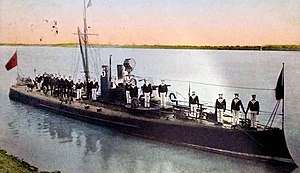
The Romanian Navy used the Škoda-produced version of the gun. The gun was used as secondary and later tertiary armament on the Romanian monitors of the Mihail Kogălniceanu class. It also served as the main armament of the Căpitan Nicolae Lascăr Bogdan class of armored multi-purpose boats, each of the 8 boats carrying one gun.[13][14]
Russian service
| 47 mm L/43 Hotchkiss | |
|---|---|
| Type | Naval gun |
| Place of origin | France |
| Service history | |
| Used by | |
| Wars | Russo-Japanese War World War I Russian Civil War |
| Production history | |
| Designer | Hotchkiss et Cie |
| Designed | 1883 |
| Manufacturer | Obukhov State Plant |
| Produced | 1888 |
| Specifications | |
| Mass | Gun: 235 kg (518 lb) |
| Length | 2 m (6 ft 7 in) |
| Barrel length | 1.5 m (4 ft 11 in) 43 caliber |
| Shell | Projectile: 1.53 kg (3.4 lb) |
| Caliber | 47 mm (1.9 in) |
| Breech | Vertical sliding wedge |
| Elevation | -23° to +25° |
| Traverse | 360° |
| Rate of fire | 25 rpm |
| Muzzle velocity | 701 m/s (2,300 ft/s) |
| Maximum firing range | 4.5 km (2.8 mi) at 10°[15] |
Russia adopted the Hotchkiss 3-pounder 5-barrel revolver cannon in the 1880s, and later adopted the less complicated single-barrel 43 caliber quick-firing weapon. The 5-barrel guns were equipped on the Ekaterina II-class battleships commissioned in 1889 but by 1892 the battleship Dvenadsat Apostolov and her successors had single-barrel weapons. In 1888 licensed production of a Russian variant started at the Obukhov State Plant.[16] During the Russo-Japanese War, ships of both sides were armed with Hotchkiss 3-pounders, which were found to be ineffective against Japanese torpedo boats and were removed from first-line warships after the war. The Evstafi class, commissioned in 1910 ceased carrying the weapon but they were later fitted to patrol vessels and river craft during World War I and at least 62 weapons were converted to anti-aircraft guns by 1917.[15]
Russian ships armed with 3-pounder guns include:
- Admiral Ushakov-class coastal defense ships
- Amur-class minelayers
- Bayan-class cruisers
- Bogatyr-class cruisers
- Borodino-class battleships
- Derzky-class destroyers
- Izumrud-class cruisers
- Peresvet-class battleships
- Petropavlovsk-class battleships
- Russian battleship Navarin
- Russian battleship Potemkin
- Russian battleship Retvizan
- Russian battleship Rostislav
- Russian battleship Sissoi Veliky
- Russian battleship Tri Sviatitelia
- Russian battleship Tsesarevich
- Russian cruiser Admiral Kornilov
- Russian cruiser Admiral Nakhimov (1885)
- Russian cruiser Almaz
- Russian cruiser Askold
- Russian cruiser Boyarin
- Russian cruiser Gromoboi
- Russian cruiser Pamiat Azova
- Russian cruiser Rossia
- Russian cruiser Rurik (1892)
- Russian cruiser Rurik (1906)
- Russian cruiser Svetlana
- Russian cruiser Varyag
- Russian cruiser Vladimir Monomakh
- Russian yacht Standart
United Kingdom service
In 1886 this gun was the first of the modern Quick-firing (QF) artillery to be adopted by the Royal Navy as the Ordnance QF 3 pounder Hotchkiss, built under licence by the Elswick Ordnance Company.[17]
By the middle of World War I the Hotchkiss gun was obsolescent and was gradually replaced by the more powerful Ordnance QF 3 pounder Vickers gun. Of the 2,950 produced it is estimated that 1,948 were still available in 1939 for RN use.[18] The availability, simplicity and light weight of the gun kept it in use in small vessels and many were later brought back into service on merchant vessels used for auxiliary duties in World War II or as saluting guns and sub-calibre guns for gunnery practice until the 1950s. Early in WWII, it was also pressed into service in ports around the British Empire, to defend against possible incursions by motor torpedo boats, until the modern QF 6 pounder 10 cwt gun became available.
Royal Navy ships armed with QF 3-pounder Hotchkiss guns include:
- Admiral-class ironclads
- Adventure-class cruisers
- Alert-class sloops
- Arrogant-class cruisers
- Astraea-class cruisers
- Blake-class cruisers
- Bramble-class gunboats
- C-class cruisers
- Cadmus-class sloops
- Canopus-class battleships
- Centurion-class battleships
- Challenger-class cruisers
- Colossus-class battleships
- Condor-class sloops
- Conqueror-class monitors
- Cressy-class cruisers
- Cyclops-class monitors
- Devastation-class ironclads
- Devonshire-class cruisers
- Diadem-class cruisers
- Drake-class cruisers
- Duncan-class battleships
- Eclipse-class cruisers
- Formidable-class battleships
- Forward-class cruisers
- Gorgon-class monitors
- Highflyer-class cruisers
- King Edward VII-class battleships
- King George V-class battleships
- Lord Nelson-class battleships
- Majestic-class battleships
- Marathon-class cruisers
- Monarch-class coastal defense ships
- Monmouth-class cruisers
- Orion-class battleships
- Orlando-class cruisers
- Pathfinder-class cruisers
- Pearl-class cruisers
- Pelorus-class cruisers
- Phoenix-class sloops
- Powerful-class cruisers
- Redbreast-class gunboats
- Royal Sovereign-class battleships
- Sentinel-class cruisers
- Topaze-class cruisers
- Trafalgar-class ironclads
United States service
| Manufacturer | Manufacturers Designation | US Designation | Caliber |
|---|---|---|---|
| Hotchkiss | Mk I | Mk I | 40 |
| Driggs-Schroeder | Mk I | Mk II | 45 |
| Driggs-Schroeder | Mk II (trunnionless) | Mk III | 45 |
| Hotchkiss | Mk IV semi-automatic | Mk IV | 45 |
| Maxim-Nordenfelt | Mk I semi-automatic | Mk V | 50 |
| Maxim-Nordenfelt | Mk II semi-automatic | Mk VI | 50 |
| Vickers-Maxim | Mk III semi-automatic | Mk VII | 45 |
| Hotchkiss-Armstrong | ? | Mk VIII | 40 |
| Nordenfelt | Mk I | Mk IX | 42 |
| Hotchkiss | ? | Mk X | 50 |
| US Rapid Fire Gun and Power Company | ? | Mk XI | 50 |
| Nordenfelt | Mk I semi-automatic | Mk XII | 50 |
| Vickers-Maxim | Mk M | Mk XIII | 50 |
| Driggs-Seaburry | ? | Mk XIV | 50[19][1][20] |
The US Navy used several types of 3-pounder guns from multiple manufacturers and it is difficult to determine from references which type a particular ship carried. Hotchkiss 3-pounder 5-barrel revolving cannons were used, along with single-barrel quick-firing single-shot Hotchkiss 3-pounders. Both are called rapid-firing (RF) in references. Ships on both sides in the Spanish–American War were armed with Hotchkiss 3-pounders. By 1910 the US was building the dreadnought-type South Carolina class, with a secondary armament composed entirely of 3-inch (76 mm) guns. Although removed from first-line warships by World War I, some 3-pounders were fitted on patrol vessels, with a few weapons serving on those ships through World War II.[1][18]
- Amphitrite-class monitors
- Asheville-class gunboats
- Chester-class cruisers
- Columbia-class cruisers
- Connecticut-class battleships
- Delaware-class battleships
- Maine-class battleships
- Mississippi-class battleships
- New Orleans-class cruisers
- New York-class battleships
- Northampton-class cruisers
- Pennsylvania-class cruisers
- Pensacola-class cruisers
- Portland-class cruisers
- South Carolina-class battleships
- St. Louis-class cruisers
- Tennessee-class cruisers
- Virginia-class battleships
- Willmington-class gunboats
- Wyoming-class battleships
- Yorktown-class gunboats
- USS Atlanta (1884)
- USS Baltimore (C-3)
- USS Birmingham (CL-2)
- USS Boston (1884)
- USS Charleston (C-2)
- USS Chester (CL-1)
- USS New York (ACR-2)
- USS Newark (C-1)
- USS Philadelphia (C-4)
- USS Salem (CL-3)
- USS San Francisco (C-5)
Ammunition
The most common types of ammunition available for 3-pounder guns were low yield Steel shells and common lyddite shells. In World War II higher yield high explosive rounds were produced.
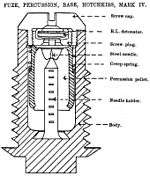 |
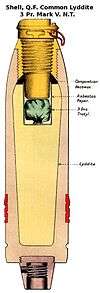 |
 | |
Photo gallery
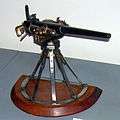 Model of gun in French service on "elastic frame" mounting (affût-crinoline), at the Musée national de la Marine Paris.
Model of gun in French service on "elastic frame" mounting (affût-crinoline), at the Musée national de la Marine Paris.- The Noonday gun at Causeway Bay, Hong Kong
.jpg) Two of the four operational QF 3 pounder Hotchkiss cannons aboard ARA Libertad
Two of the four operational QF 3 pounder Hotchkiss cannons aboard ARA Libertad- Russian Hotchkiss gun on a field carriage. Military-historical Museum of Artillery, Engineer and Signal Corps. St. Petersburg Russia.
_Collection_Q44281.jpg) British 3-pounder on an anti-aircraft mount Gallipoli 1915
British 3-pounder on an anti-aircraft mount Gallipoli 1915 A 3-pounder coastal-defense gun at Sydney harbor 1942.
A 3-pounder coastal-defense gun at Sydney harbor 1942.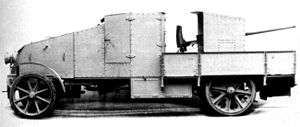 A Russian 3-pounder on a Renault armored car 1917.
A Russian 3-pounder on a Renault armored car 1917. The Imperial Russian cruiser Rossia. 3-pounders at the bottom left/right.
The Imperial Russian cruiser Rossia. 3-pounders at the bottom left/right.
Surviving examples
- The Jardines Noonday gun at Causeway Bay, Hong Kong.
- A gun at the Royal Queensland Yacht Squadron, Manly, Queensland, Australia.[21]
- Two guns on "elastic frame" mounting in the Casemate de l'Aschenbach, Uffheim, Haut-Rhin, France.[22]
- A saluting battery of multiple guns at Fort Queenscliff, Victoria, Australia.
- Four guns on the tall ship Libertad, which serves as a school ship in the Argentine Navy; all fully operational as saluting battery or multipurpose defense.[23]
- 3 guns used for ceremonial purposes at HMS Drake.
- National Museum of the United States Navy has one on display with 1910 brass gun sight and slide manufactured at the Naval Gun Factory.
Weapons of comparable role, performance and era
- QF 3 pounder Nordenfelt : Nordenfelt equivalent
- QF 3 pounder Vickers : Vickers equivalent
- 5 cm SK L/40 gun : German equivalent
Licensed production
Wars
Users
Notes
- DiGiulian, Tony. "USA 3-pdr (1.4 kg) [1.85" (47 mm)] Marks 1 through 12 – NavWeaps". www.navweaps.com. Retrieved 2017-07-05.
- "38–37 MM CALIBRE CARTRIDGES". www.quarryhs.co.uk. Retrieved 2017-07-04.
- 30 rounds per minute is the figure given by Elswick Ordnance for their 40-calibres model. Quoted in Brassey's Naval Annual 1901
- Friedman 2011, p. 118.
- Friedman 2011, p. 229.
- Navy, Royal Australian. "3-Pounder saluting guns". navy.gov.au. Retrieved 7 July 2017.
- Media, Defence News and (7 July 2017). "Defence News and Media". defence.gov.au. Retrieved 7 July 2017.
- Friedman 2011, p. 295.
- "Hai Yung protected cruisers (1898) – Chinese / People`s Liberation Army Navy (China / People`s Republic of China)". www.navypedia.org. Retrieved 2017-07-06.
- Langensiepen & Güleryüz 1995.
- Friedman 2011, p. 119.
- Tym & Rzepniewski 1985.
- Robert Gardiner, Conway's All the World's Fighting Ships, 1906-1921, Naval Institute Press, 1985, p. 422
- Е. Е. Шведе, Военные флоты 1939—1940 гг., Рипол Классик, 2013, pp. 120-121 (in Russian)
- DiGiulian, Tony. "Russia / USSR 47 mm (1.85") [3-pdr] – NavWeaps". www.navweaps.com. Retrieved 7 July 2017.
- Friedman 2011, p. 265.
- British forces traditionally denoted smaller ordnance by the weight of its standard projectile, in this case approximately 3 pounds (1.4 kg).
- Campbell 1985, p. 66.
- Friedman 2011, p. 197.
- DiGiulian and Friedman differ on the details of Mk 10-12.
- "AMMS Brisbane". www.ammsbrisbane.com. Retrieved 7 July 2017.
- Weyant, Hervé. "Mémorial Maginot de Haute-Alsace". www.maginot68.com. Retrieved 7 July 2017.
- Jane's Fighting Ships 2005–2006
References
- Campbell, John (1985). Naval Weapons of World War Two. Annapolis, MD: Naval Institute Press. ISBN 978-0-87021-459-2.
- Friedman, Norman (2011). Naval Weapons of World War One. Barnsley, South Yorkshire, UK: Seaforth. ISBN 978-1-84832-100-7.
- Langensiepen, Bernd & Güleryüz, Ahmet (1995). The Ottoman Steam Navy 1828–1923. London: Conway Maritime Press. ISBN 978-0-85177-610-1.
- Tym, Wacław; Rzepniewski, Andrzej (1985). Kępa Oksywska 1939: relacja uczestników walk lądowych [Oksywska Fort 1939: Relations of Combatants on Land] (in Polish). Gdańsk: Wydawnictwo Morskie. ISBN 978-83-215-7210-9.
External links
| Wikimedia Commons has media related to QF 3 pounder Hotchkiss. |
- Handbook of the 3 pounder Hotchkiss quick-firing gun Land service 1892, 1900 at State Library of Victoria
- Handbook for Hotchkiss 6-pr and 3-pr. quick-firing guns 1896 at State Library of Victoria
- Tony DiGiulian, British Hotchkiss 3-pdr (1.4 kg) (1.85"/40 (47 mm)) QF Marks I and II
- DiGiulian, Tony, US 3-pounders
- DiGiulian, Tony, Russian Hotchkiss 3-pounders